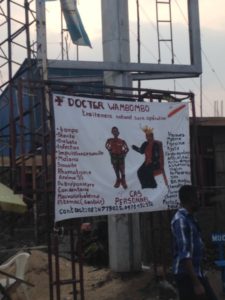
As a medical anthropologist I have a vested interest in understanding cultural conceptions of health and illness and the different avenues and tools people turn to for care and well-being. Traditional healing is regarded as one of the oldest forms of medicine and used to be an integral part of agricultural societies. Traditional medicine involves the use of herbs, plants, animal or mineral-based medicines, energetic therapies, and/or somatic techniques. When I got to Goma, I didn’t realize how much of a prominent role traditional healing played in Congo. I remember my friend in Uganda telling me that her family drove her nine hours to Congo to see a traditional healer because nothing was working and Western biomedicine wasn’t helping her. I asked my Congolese friends if they had ever visited a traditional healer or knew anyone who did and the majority explained that they usually went to the healer as a second option. “If the doctors in the hospital can’t help or if the hospital fees are too expensive, we go to the healers.” After meeting Dr. Pascal, a pharmacist who integrates healing remedies with biomedical treatments, and hearing about his cutting-edge research on treating malaria with a local herb, I wanted to hear more about his story and the work of traditional healers in Congo.
He introduced me to an older lady who has practiced traditional medicine for over ten years. She only spoke Swahili so with the help of Papa Pascal, I was able to ask her some questions. She explained that a Congolese doctor trained in London, Father Cyrille, came to her village when she was young and recruited people who were interested in learning the methods of traditional medicine. She reflected how special it was because he didn’t care about identity, ethnic background, or whether you were rich or poor, young or old –just people who were interested in learning a vocation that helps people. She took the opportunity and left the village. After extensive training with Father Cyrille, thousands of people came to her for help. She explained that most people first go to the hospital and then come to her. She explained people come to her for stomach ailments, malaria, high blood pressure, hemorrhoids, fibrosis, prostate problems, urinary infections, and birthing issues. Some of the herbs she uses are: locomost for trouble sleeping, capsine for kidney issues, sedatox for nerves and insomnia. When biomedicine fails, people rely on traditional medicine, especially with chronic or difficult cases. She explained that traditional healing has become a lucrative job and now many young people are trying to bring roots and herbs to sell on the street. It’s a way to survive, but some of them are not trained.
A few weeks after my meeting with the traditional healer, I started seeing signs advertising traditional medicine along the streets of Goma. This was a rare sight to see because traditional healing was something that was kept discreet due to the stigma around it. The signs around Goma was a testament to people’s need for care and support in an uncertain and precarious environment.